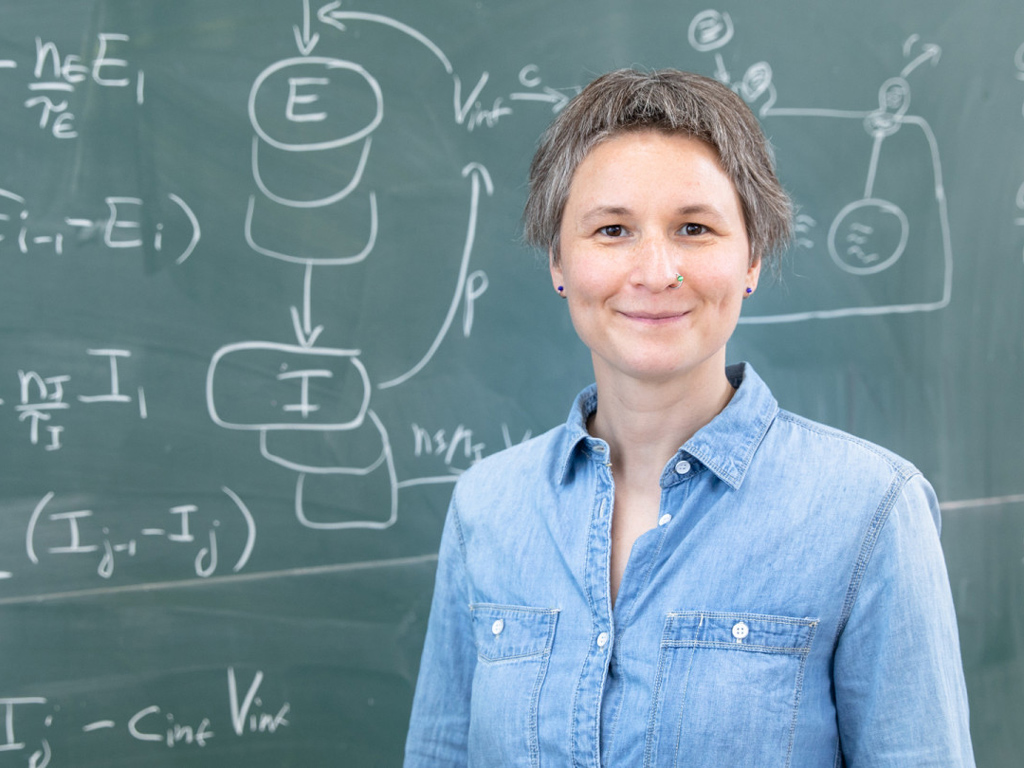Complex Systems Series: Spotlight on Catherine Beauchemin

Catherine Beauchemin
From early days in graduate school, Catherine Beauchemin forged a long, often solitary path pioneering the field of virophysics. Now she’s a long-time professor at Ryerson University’s Department of Physics, and a Deputy Program Director of the Interdisciplinary Theoretical and Mathematical Sciences (iTHEMS) (external link) program at RIKEN, Japan’s largest comprehensive scientific research institute. She’s also one of four researchers offering graduate training through Physics’s new Complex Systems field.
Amid the global COVID-19 pandemic, the media has sought her expert commentary on viruses, and interest in her field is growing. Beauchemin gave us a glimpse into her research, its relation to complexity science, and what her students may experience as virophysics research trainees.
You are the originator of virophysics. How did that happen, and what is it?
Virophysics is an interdisciplinary field that uses physics to solve problems in virology. I’m a classically trained physicist. During graduate school, I began using math to describe the behaviour of influenza viruses. However, quantitative modelling of virus infections didn’t fit neatly into medicine, biology or even biophysics or medical physics. I had to brand my work, and developed the field of virophysics as a result.
Knowledge in virology normally takes the form of a description using words and images. By expressing that knowledge as equations instead, like in physics, we can quantify how well it agrees with experiments and identify gaps or issues. I think it’s a very powerful and critical way to approach scientific knowledge-building and validation.
What kind of research does your team conduct?
We use mathematical models and computer simulations to describe the spread of virus infections in cell cultures or hosts. We’re known for our expertise in influenza, but we’ve also worked on the hepatitis C virus, Ebola, HIV and others. We’re not a wet lab: we don’t conduct live infection experiments. We work from data gathered by our experimental collaborators, or from the literature.
My group mostly works on virus spread at the scale of whole cell cultures — around one million cells. We seek to determine infection parameters, like how long it takes the virus to infect a cell, how long before the cell produces virus, for how long, at what rate, etc. To make sure we get the data we need for this, we often participate in designing and planning the experiments — what to measure, how, and when. Once we determine the infection parameters from the data, we can see which ones are disrupted by whatever condition we’re interested in, like the impact of introducing an antiviral drug, or a virus mutation that maybe increases virus spread or drug resistance. We can say what it affected (where it acts), and by how much.
Ryerson now offers formal training in Complex Systems — one of only a few in North America?
Yes, we hope that its debut at Ryerson will attract students who want to enter this field. Many important systems are characterized by large numbers of interconnected, moving parts. That’s where complex systems science comes in. It’s not specific to any one field of application, but is a methodology for working with nonlinear, self-organizing systems that are inherently difficult to model or predict, but share some common mechanisms.
COVID-19 has ignited interest in your expertise. A virus infection is a complex system?
Yes. For example, when your immune system encounters a virus for the first time, only a few random immune cells that happen to carry the right “key” to match the virus “lock” can recognize it. Only these cells are triggered to begin dividing, making a lot more cells like themselves to attack the virus and infected cells. When the infection ends, you’re left with more of these specific immune cells, and when you encounter this virus again, it means your immune system can find and clear the virus sooner, before it causes too much damage.
So, learning about the virus is not organized by a central brain that gathers information and makes a decision; it happens many times, at a small, local scale whenever an individual cell matches the virus and divides. And memory of the virus encounter is not held in a single knowledge centre; it is encoded in the fact that your immune system is composed of more of these matching cells, and less of the other types. The proportion of each cell type that your immune system contains reflects the history (i.e. your immune memory), of past encounters with pathogens. Even if you lose several immune cells, this information is not lost because it is distributed over the whole system. This type of self-organizing, emergent learning pattern, and distributed intelligence are classic features of complex systems.
Beauchemin in the Media
COVID-19 emergency measures (external link) , Y a pas deux matins pareils, Radio-Canada
Modelling of COVID-19 variants (external link) , Téléjournal de l'Ontario, Radio-Canada
Lecture on virophysics (external link) modelling, streamed on TVO
What type of students would thrive in your virophysics group?
The work is not related to medical physics, as that’s more about imaging and treatment modalities for diseases like cancer. The best fit in my research group are traditional, run-of-the-mill physics students. No experience with biology or virology is expected or required either. Instead, there’s a lot of data analysis, solving math equations, and high-performance computing. So, students should have natural ability in physics, math and statistics, and should enjoy and be good at computer programming. Students can visit my virophysics website and reach out to me about their research interests.

Complex Systems at Ryerson
Check out more professors and research in the new field:
